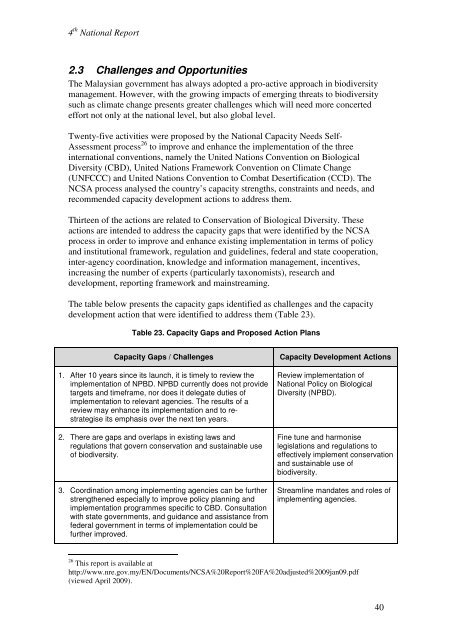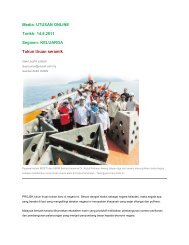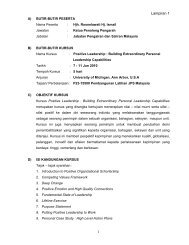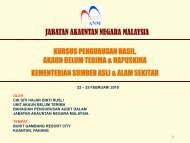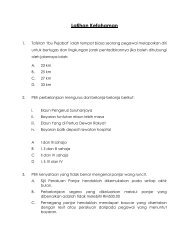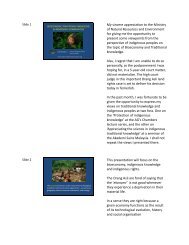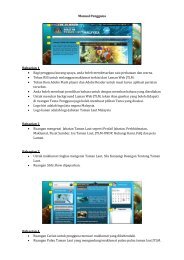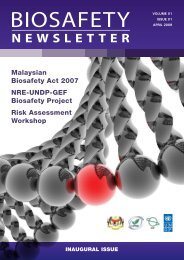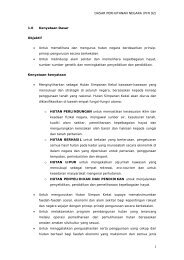4th National Report to CBD - NRE
4th National Report to CBD - NRE
4th National Report to CBD - NRE
Create successful ePaper yourself
Turn your PDF publications into a flip-book with our unique Google optimized e-Paper software.
4 th <strong>National</strong> <strong>Report</strong><br />
2.3 Challenges and Opportunities<br />
The Malaysian government has always adopted a pro-active approach in biodiversity<br />
management. However, with the growing impacts of emerging threats <strong>to</strong> biodiversity<br />
such as climate change presents greater challenges which will need more concerted<br />
effort not only at the national level, but also global level.<br />
Twenty-five activities were proposed by the <strong>National</strong> Capacity Needs Self-<br />
Assessment process 26 <strong>to</strong> improve and enhance the implementation of the three<br />
international conventions, namely the United Nations Convention on Biological<br />
Diversity (<strong>CBD</strong>), United Nations Framework Convention on Climate Change<br />
(UNFCCC) and United Nations Convention <strong>to</strong> Combat Desertification (CCD). The<br />
NCSA process analysed the country’s capacity strengths, constraints and needs, and<br />
recommended capacity development actions <strong>to</strong> address them.<br />
Thirteen of the actions are related <strong>to</strong> Conservation of Biological Diversity. These<br />
actions are intended <strong>to</strong> address the capacity gaps that were identified by the NCSA<br />
process in order <strong>to</strong> improve and enhance existing implementation in terms of policy<br />
and institutional framework, regulation and guidelines, federal and state cooperation,<br />
inter-agency coordination, knowledge and information management, incentives,<br />
increasing the number of experts (particularly taxonomists), research and<br />
development, reporting framework and mainstreaming.<br />
The table below presents the capacity gaps identified as challenges and the capacity<br />
development action that were identified <strong>to</strong> address them (Table 23).<br />
Table 23. Capacity Gaps and Proposed Action Plans<br />
Capacity Gaps / Challenges<br />
1. After 10 years since its launch, it is timely <strong>to</strong> review the<br />
implementation of NPBD. NPBD currently does not provide<br />
targets and timeframe, nor does it delegate duties of<br />
implementation <strong>to</strong> relevant agencies. The results of a<br />
review may enhance its implementation and <strong>to</strong> restrategise<br />
its emphasis over the next ten years.<br />
2. There are gaps and overlaps in existing laws and<br />
regulations that govern conservation and sustainable use<br />
of biodiversity.<br />
3. Coordination among implementing agencies can be further<br />
strengthened especially <strong>to</strong> improve policy planning and<br />
implementation programmes specific <strong>to</strong> <strong>CBD</strong>. Consultation<br />
with state governments, and guidance and assistance from<br />
federal government in terms of implementation could be<br />
further improved.<br />
Capacity Development Actions<br />
Review implementation of<br />
<strong>National</strong> Policy on Biological<br />
Diversity (NPBD).<br />
Fine tune and harmonise<br />
legislations and regulations <strong>to</strong><br />
effectively implement conservation<br />
and sustainable use of<br />
biodiversity.<br />
Streamline mandates and roles of<br />
implementing agencies.<br />
26 This report is available at<br />
http://www.nre.gov.my/EN/Documents/NCSA%20<strong>Report</strong>%20FA%20adjusted%2009jan09.pdf<br />
(viewed April 2009).<br />
40


